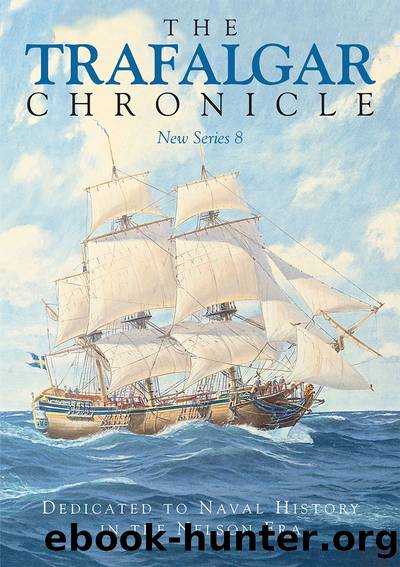The Trafalgar Chronicle: Dedicated to Naval History in the Nelson Era: New Series 8 by Judith Pearson & John Rodgaard

Author:Judith Pearson & John Rodgaard [Pearson, Judith & Rodgaard, John]
Language: eng
Format: epub
ISBN: 9781399039031
Google: 0izaEAAAQBAJ
Publisher: Seaforth Publishing
Published: 2024-03-07T21:00:00+00:00
Crippled but unconquered, HMS Belleisle at Trafalgar 1805, by William Lionel Willie (1851â1931). Belleisle had to fight against seven enemy ships and lost her rigging early on. She fought for forty-five minutes before other British ships came to her assistance. Original in Army and Navy Club, London. (BritishBattles.com)
In HMS Defence were two pressed men, John Jacobs and Andrew Spackman, and a volunteer, Nicholas Lice. There they were joined by two prime seamen, Jan Janfors and Peter Bjorg, who were both captured in a dutch ship on 4 April 1804 and promptly volunteered. Jacobs and Spackman deserted on 10 and 12 June 1805, the dates suggesting that they colluded in their escape, but Lice, Janfors and Bjorg fought at the Battle of Trafalgar. Janfors and Bjorg were sufficiently reliable men to serve for seven days after the battle as part of the prize crew of the Spanish San Ildefonso which, though dismasted in battle and despite a storm, was successfully sailed to Gibraltar, where they rejoined Defence on 6 November 1805.
There were three Swedes in HMS Defiance. Able Seaman Nicholas Coleman volunteered on 6 July 1803, but on 11 February 1805 he was sent to the naval hospital at Paignton suffering from venereal disease; he was not cured until 30 May. The other two were Alexander Walin â surely Alexander Wallén â and the curiously named Juiro Flackness, who both volunteered at Cawsand Bay on 6 August 1803.
Even the smallest English ship off Trafalgar, Entreprenante, carried two Swedes in her crew of thirty-two. Entreprenante was just over 20m in length, certainly the wettest ship off Cadiz, and one wonders where the crew all slung their hammocks. Able Seaman Andrew Sanderson appears to have been thoroughly anglicised. He was a volunteer, and a skilled man serving â though he could not write â as carpenterâs mate in the little Entreprenante. He was also a family man who remitted a large portion of his wages to his wife Charlotte, who lived near Plymouth. His service was long enough for him to receive both a share of the prize money and £4 12s 6d from the Parliamentary Award. Able Seaman Angus Pillstream, or more likely Adolphus Pilström, aged twenty-four, was another Swedish volunteer in Entreprenante: though he was awarded a share of the prize money and of the Parliamentary Award, he disappeared from the ship and the historical record before he could collect either and the proceeds went to Greenwich Hospital.
Ordinary Seaman Oliver Westerland in HMS Mars (more probably Olaf Västerland or Westerlund) was wounded at the Battle of Trafalgar. Injured in the back, he spent five days in the naval hospital at Gibraltar, before returning to England in Mars and being âdSâ or âdischarged sickâ to Haslar Hospital. In 1806 he was awarded a pension of £5 for one year from the Chatham Chest at Greenwich, and £20 from Lloydâs Patriotic Fund. These grants bring us a little more information about Westerlund: he was tall and of light complexion, and his parents were called John and Hannah Westerlund.
Download
This site does not store any files on its server. We only index and link to content provided by other sites. Please contact the content providers to delete copyright contents if any and email us, we'll remove relevant links or contents immediately.
Fanny Burney by Claire Harman(26483)
Empire of the Sikhs by Patwant Singh(22907)
Out of India by Michael Foss(16753)
Leonardo da Vinci by Walter Isaacson(13106)
Small Great Things by Jodi Picoult(6867)
The Six Wives Of Henry VIII (WOMEN IN HISTORY) by Fraser Antonia(5358)
The Wind in My Hair by Masih Alinejad(5009)
A Higher Loyalty: Truth, Lies, and Leadership by James Comey(4797)
The Lonely City by Olivia Laing(4708)
The Crown by Robert Lacey(4690)
Millionaire: The Philanderer, Gambler, and Duelist Who Invented Modern Finance by Janet Gleeson(4300)
The Iron Duke by The Iron Duke(4253)
Papillon (English) by Henri Charrière(4146)
Sticky Fingers by Joe Hagan(4064)
Joan of Arc by Mary Gordon(3981)
Alive: The Story of the Andes Survivors by Piers Paul Read(3923)
Stalin by Stephen Kotkin(3826)
Aleister Crowley: The Biography by Tobias Churton(3535)
Ants Among Elephants by Sujatha Gidla(3362)
